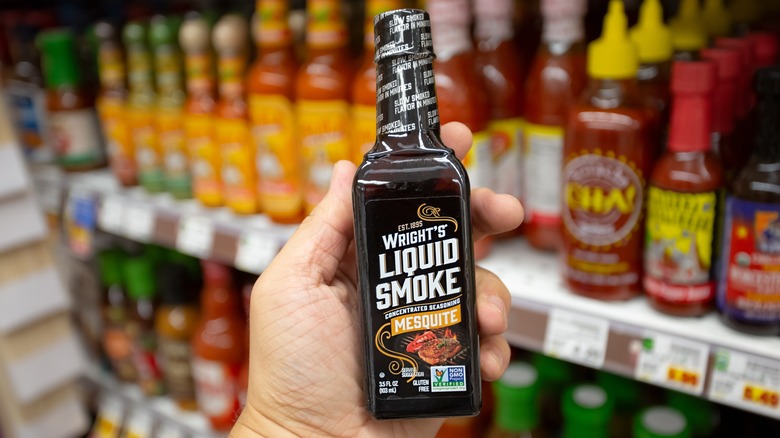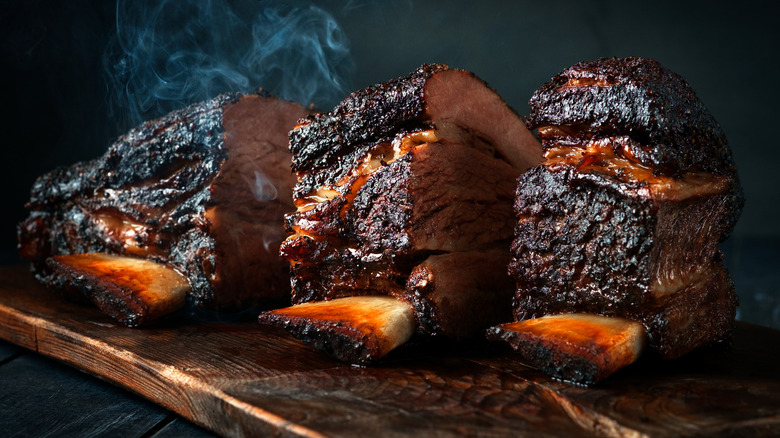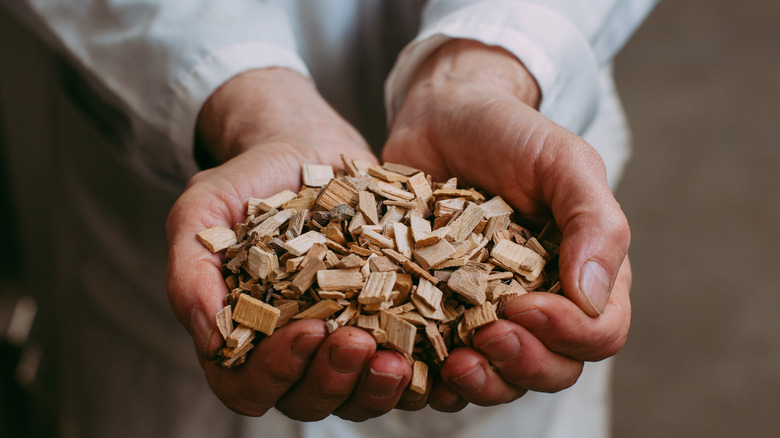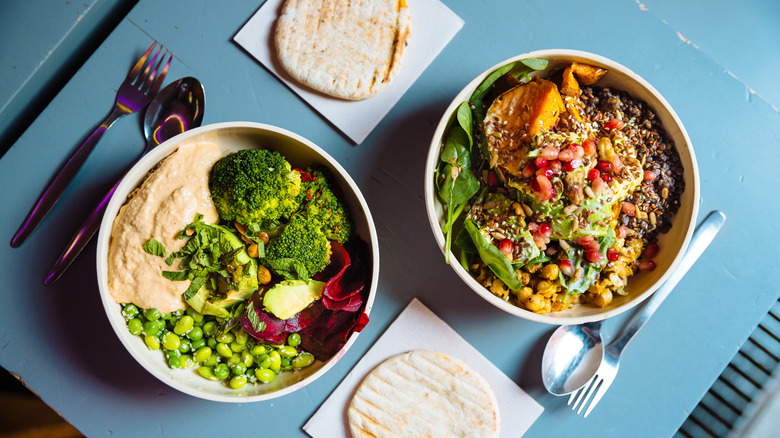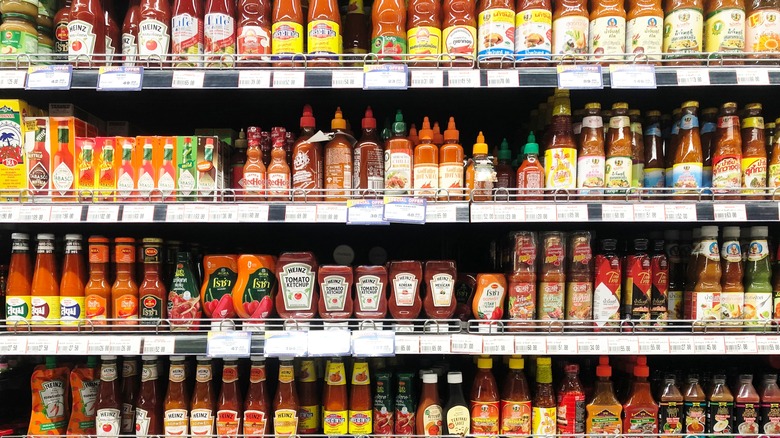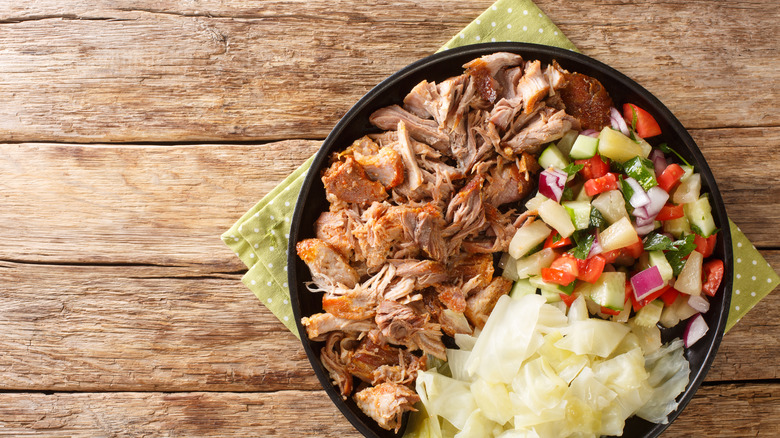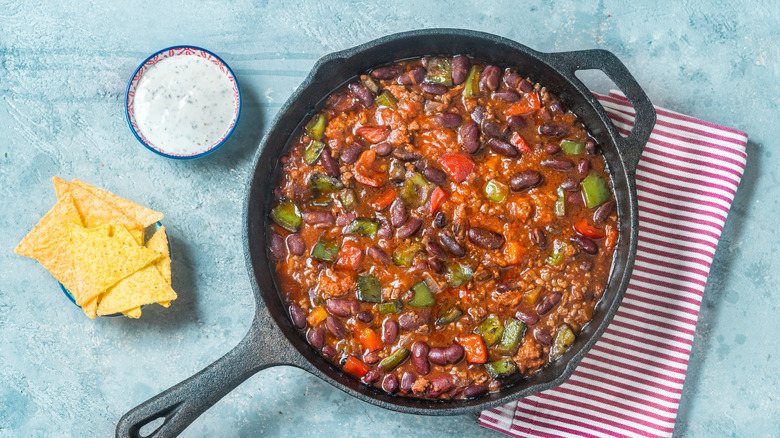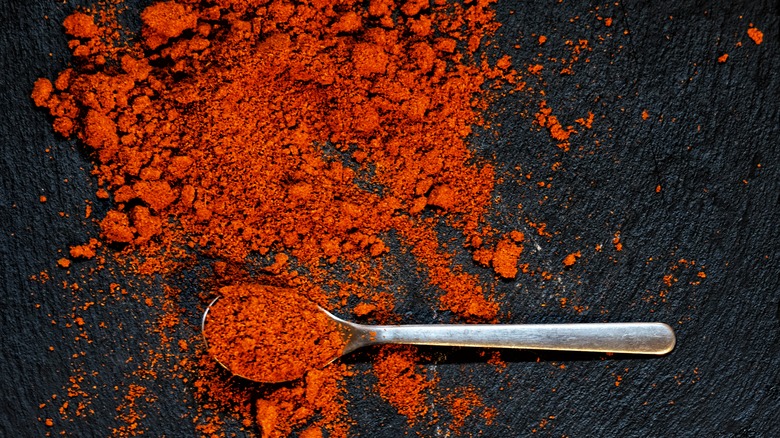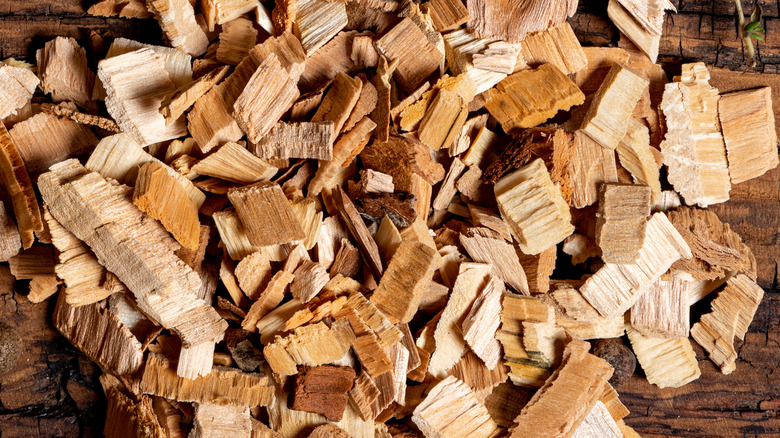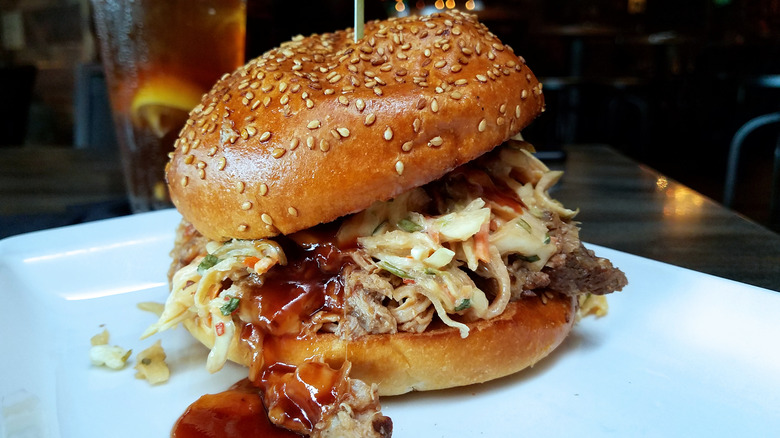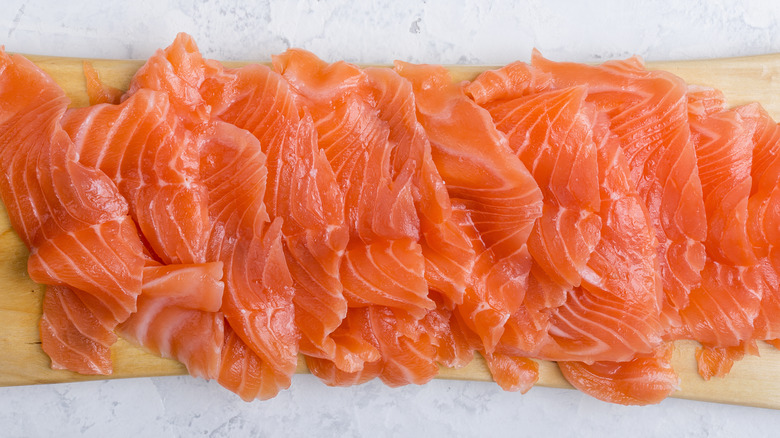What Is Liquid Smoke And Why Should You Care?
As someone who doesn't have a smokehouse and is almost always too lazy to barbecue, but who absolutely loves that home-grilled flavor, liquid smoke has become a favorite go-to for easy cooking. It has been called the "instant coffee of barbecue" for a reason. This ingredient comes in clutch when used in homemade jerky, Kalua pork, and ribs. You can add it during baking and slow cooking, or brush it onto dishes afterward for a smokehouse finish. And if you use a gas grill rather than charcoal, it is perfect for helping to make up some of that missing smoky flavor.
Uses for liquid smoke are not confined to meat, though. You can also use it in chili, soups, and even fondue. (Yes, fondue, the most '60s kind of cheesy dish that we should definitely bring back immediately.) In other words, if you're not using it yet, what are you even doing?
However, liquid smoke is strong, and a little goes a long way. For that reason, it's important to harness its power for good. Understanding what it is, as well as when and how you use it, is critical. Accordingly, here's a crash course on getting liquid smoke into your kitchen rotation.
What is liquid smoke?
Some things in life are easy, and liquid smoke is one of them. It's just smoke-flavored water that you can use to liven up both savory and sweet dishes. Some types of liquid smoke have additional ingredients, such as vinegar or caramel coloring, and they usually contain salt. Many grocery store products use liquid smoke, from hot dogs to beef jerky and beyond. Recently, it has become a staple in the home chef's pantry as well.
Liquid smoke is beloved by some chefs because it is an easy way to add that smoky barbecue flavor without actually burning wood chips or even charcoal. This majorly cuts down on prep time and expense when it comes to culinary creations meant to taste like they just came off the grill. Even if you do have time to fire up the barbie, you may not want to fuss with charcoal or mesquite chips, in which case, liquid smoke is your best friend.
When was it created?
Liquid smoke has been around for quite some time. Its origins stretch back to 1895 when pharmacist Ernest H. Wright (of Wright's Liquid Smoke) first noticed that smoke condenses when it comes into contact with cold air. This gave him the idea of collecting and purifying smoke products and then selling them to farmers for incorporation into their meat products. And voilà! A delicious and easy kitchen alternative was born.
During its early days, liquid smoke was also employed as a preservative. Indeed, research in the journal Frontiers in Microbiology shows that it does work this way, extending the shelf life of products that contain it by as much as three weeks, depending on its concentration. However, it is not the most effective preservative, so early users ditched it for that purpose. Hence why it is mostly used as a flavoring agent today, a job at which it excels.
Liquid smoke ingredients and production
As this seasoning includes the word "smoke" right there in the name, you won't be surprised to learn that liquid smoke is made by burning wood and then capturing the resulting essence. However, the wood is typically burned at high heat to keep it smoldering rather than flaming, releasing smoke slowly as in a smokehouse. Then, in a process akin to when that smoke condenses on the surface of meat, the smoke's vapors condense on cold surfaces (to which smoke is attracted) inside the production equipment, where they are rapidly chilled and purified. During the filtration process, harmful and nasty-tasting ingredients such as soot and ash get removed.
Much like the barbecue sauce that accompanies many grilled meats, liquid smoke varies in flavor and usage depending on its ingredients. Unlike the huge variety of barbecue sauces in the U.S. alone, however, there's only so much variation when it comes to a formula that essentially amounts to purified and condensed gas. That said, the flavor of liquid smoke can change according to what type of wood is used during the smoking process: hickory, mesquite, applewood, and pecan are common choices.
Liquid smoke: Part of a vegan diet?
Good news for the plant-based set: liquid smoke is completely vegan. Because it is made from wood chips and water with the addition of a few seasonings, almost all (if not all) liquid smoke varieties are plant-based. Looking for products that are 100% water and smoke, and labeled "free from other additives," can help ensure a fully plant-based ingredient.
Many vegans miss out on classic barbecue because they don't eat meat. The most common substitute, barbecued or smoked tofu, is delicious and useful in lots of dishes (think tofu scrambles and sandwiches), but who wants to be restricted to only a few ingredients? With liquid smoke, you can liven up any other vegan dish as well, from dips and beans to veggies and fake meat. As with any liquid smoke, you can enjoy vegan products in a range of flavorings depending on the wood that was used during smoking.
How to choose liquid smoke at the store
Choosing liquid smoke isn't a difficult task. Depending on where you live, though, you may find more options than others. For instance, the U.S. has more choices than the European Union. Here, you can find flavors ranging from hickory to mesquite to applewood, whereas food laws in other places may prove more restrictive on production. For Americans who love their BBQ sauce variety, though, you should be safe, and you'll probably find it near the barbecue sauces too.
Depending on the flavor profile for which the manufacturers are shooting, they may add other ingredients as well (e.g., apple and maple flavoring to the applewood variety). The best way to determine what's in a bottle is, not surprisingly, to check the ingredient label. If you're at a store, this is easy. Online, click through the images until you find the one listing the ingredients. It should show you not only the materials used to make the smoke but also the nutritional information, discussed further below.
How do cooks use liquid smoke?
The main reason you would use liquid smoke is to make up for a lack of grilling or smoking, i.e. you want your food to taste like you went the extra mile when you have no such plans to do so. For instance, you can make kalua pork, one of this writer's fave Instant Pot meals, without tending a firepit (or an entire pig) all day. It's easy to add that smoky flavor to brines, marinades, or barbecue sauces in one step.
You can also use it to add smoky flavor to a huge array of other meat products, such as fish, beef jerky, and so on. And it's not just meat, either. Anything you might grill can benefit from liquid smoke too, such as veggie skewers. And extra firm grilled tofu, which has an almost steak-like quality, is made even better with the addition of a bit of liquid smoke.
Do note, however, that liquid smoke has a dark side. It is often used at restaurants to cover up bad barbecue. It can also overpower the otherwise yummy flavors of rubs or natural smokiness, which is why you should be wary of pre-sauced meat at any barbecue restaurant and should add sauce sparingly after you taste your dish. This isn't to say liquid smoke is bad, only that if you're paying for the real thing, you should get it.
Other ways to use liquid smoke in the kitchen
The most obvious use for liquid smoke is to add that grilled or smokehouse flavor to your meat dishes. However, you can use liquid smoke in a variety of other recipes as well, far beyond incorporating it into marinades, brines, and sauces.
For instance, it's the perfect way to take canned chili to the next level and an ideal ingredient for preparing easy gas-grilled asparagus that tastes like they were cooked over a charcoal fire. And if you're looking to recreate McDonald's famous breakfast sauce, guess what? Yep, liquid smoke is the secret ingredient, along with mayo, lemon juice, cheddar cheese and buttermilk powders, herbs, spices, and autolyzed yeast.
You can also use liquid smoke to dress up everyday staples. For instance, you can give storebought guacamole a big kick by grilling an avocado and adding it, along with a touch of liquid smoke. Mac and cheese, shrimp cocktail, and boiled peanuts all benefit from a bit of smokehouse flavor as well. It is also a critical ingredient in really good baked beans, along with ketchup, molasses, spices, and bacon. However, if you're a plant-based person, you can skip the bacon completely and you won't miss the flavor as much due to the liquid smoke. Yay!
Liquid smoke for cocktail hour and dessert
No need to confine liquid smoke to the lunch and dinner hour or the savory foods table. Believe it or not, you can use it in cocktails and desserts too. It goes perfectly with many classically sweet flavors, which isn't actually that strange given our long-standing love affair with the bacon donut. If you want to put a fun twist on dessert o'clock, try incorporating liquid smoke into caramel pecan sauce, chocolate chip cookies, and bourbon chocolate fudge, among others.
The drinks are even more fun, as smoky flavors pair quite well with whiskey, mezcal, and no-proof ingredients such as tomato juice, simple syrup, and lemon. Tequila Sours, a yummy orange-maple Old Fashioned, and Manhattan cocktails all get a nice upgrade with the addition of a little smokiness. If you're really jonesin' to get creative, try making smoked ice cubes by subbing out actual smoke and subbing the liquid in.
Substitutes for liquid smoke
Your best bet if you don't have liquid smoke is to use another smoked ingredient, such as chipotle or smoked paprika. These are both smoked during the production process, so they carry that same nice aroma and flavor. However, as both are made from peppers, they can be very hot, especially chipotle. Make sure your recipe can accommodate heat, and if not, look for mild smoked paprika, which is widely available in stores. If those aren't available, try smoked salt or smoked tea.
Alternatively, you can mix smoked meat, smoked fish, or barbecue sauce into your dish. Depending on what you're making, this is a nice way to impart smoky flavor and complexify your recipe further. For instance, if you don't have smoked clams for your clam chowder, you could use regular clams and sub in some smoked salmon for an extra seafood kick. If your dish is cheesy, then subbing in a smoked gouda or Swiss will do the trick as well.
Of course, you can also go ahead and smoke or grill your recipe, assuming it's meat, seafood, or veggies and will hold its shape. This is the best way to get that traditional barbecued flavor, after all. At this point, though, you should just use a different recipe: one that is created for the cooking medium you intend. This will give you the best results and help avoid the sometimes unforeseeable mishaps of substitution in recipes.
Overusing liquid smoke
The main problem with liquid smoke is going overboard. Remember that liquid smoke is made via a literal burning process, so if you add too much of it, you're just going to get the ashy and bitter taste that comes from smoldering wood. Some describe it as chemical, which is the only flavor that could be worse than "ashy," IMHO.
As such, use a light hand. A little smoke goes a long way. As the recipe you use will tell you exactly how much to add, you really have no excuse for going overboard. Be especially cautious when using it in desserts, as it will overpower sweet flavors more quickly than umami ones and you could wind up with a ruined caramel sauce or bourbon ball on your hands.
If you find your dish has too much smoked flavor, there are ways to correct the problem. For instance, you can blend your meat with a sauce that contains sweet and spicy flavors. These will balance everything out and help mask the bitterness. For other recipes, you can try to add ingredients that weren't called for to neutralize the flavor. In a dessert, you might want to add cream, whereas for veggies, some balsamic vinegar might help. Most likely it will take some experimenting to figure out how to correct the seasoning, as it does with any other, so don't beat yourself up. You have to break a few eggs to make an omelet.
Can you make your own liquid smoke?
Yes, you can make your own liquid smoke. No, you cannot make your own liquid smoke without a large amount of equipment and possibly a degree in engineering. In all seriousness, though, if you love a good invention and have time to spend building culinary Rube Goldberg machines, then this is likely a project for you.
Essentially, making your own liquid smoke involves capturing flavor compounds in a liquid medium. Sometimes, this is easier, as is the case for making your own vanilla extract by soaking the beans in alcohol and just waiting for it to get all flavor-y. Other recipes call for heat, such as infusing garlic into olive oil. Liquid smoke is, unfortunately, much fussier than either of these two processes.
You have to carefully heat wood chips to a high enough temperature that the lignin burns, which happens at 752 degrees Fahrenheit. You then have to run the smoke through water in an oxygen-free environment, thus capturing the water-soluble flavor compounds and discarding the rest. This is, as you might imagine, technical to the extreme, but tutorials exist online if you are so motivated.
Is liquid smoke safe to consume?
Spoiler alert: liquid smoke is pretty safe. Although smoke is rightly associated with carcinogens and therefore smoked meats may be somewhat problematic, the liquid version isn't in the same way. Bacterial studies have shown that liquid smoke flavorings are not mutagenic, meaning they do not cause changes to DNA that can lead to cancer. Plus, common foods such as smoked lox often have way more than the recommended daily limit of carcinogenic compounds, and we eat them without blinking.
The good news vis-à-vis liquid smoke flavorings is that the carcinogens carried by smoke are soluble in fat, not water, and liquid smoke is water-based. Therefore, it does not capture those compounds, giving us the flavor without the risk of cancer. And while it does contain trace carcinogenic compounds, they are way below the safe daily limit.
One note of caution for the DIY crowd: don't soak smoked wood chips in water to make low-rent "liquid smoke." That isn't the same process at all, won't result in the same product, and could result in a whole lot of carcinogens in your life.
Storing liquid smoke to last
As with most other seasonings, air and light impact the potency of liquid smoke, reducing its effects and potentially introducing funky flavors to your batch. As such, you will want to keep it tightly sealed in a cool, dark place. Stored correctly, it can last years after opening, though it is best used within a year or two to maintain maximum freshness.
Some brands claim a 4-year shelf life, however, so take your cue from the individual brand. Given that liquid smoke contains few ingredients that actually go "bad," as in can cause you to get sick, you're probably fine using it for longer as long as it doesn't smell funny. Plus, its low pH factor (typically between 1.5 and 5.5) is likely to keep it good even longer, on top of the antimicrobial properties discussed earlier.
It is not necessary to refrigerate liquid smoke after opening; it will stay good at normal temperatures as long as you keep it in a bottle with a good seal. However, refrigerating it might extend its shelf life further, as long as that doesn't introduce weird flavors via improper storage (e.g. bad seals). Given liquid smoke's years-long viability, however, this is likely unnecessary unless you live somewhere extremely hot without good ventilation.
Nutritional information
Some brands of liquid smoke, such as Colgin's, contain no calories and no fat. The same goes for Wright's, another big name on the market. However, other purveyors may use other ingredients, and whether their sauces contain sugars or other caloric ingredients depends on the formula. With the prevalence of small-batch, artisanal, mom-and-pop brands on the market today, it is impossible to say definitively.
Moreover, according to nutritional databases, other formulas do contain calories. They are still found in low amounts, around five calories per teaspoon. Since you rarely need more than that in an entire dish, this is negligible. Indeed, using more liquid smoke than called for is bound to be a scarring experience not likely to be repeated, so most home cooks needn't worry about overuse at all. Most liquid smoke is naturally gluten- and dairy-free as well (hence the vegan tag), so it's ideal for those who have restrictions due to allergies.
